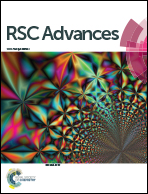An assessment of the potential of invasive weeds as multiple feedstocks for biofuel production†
Abstract
The present study assessed the feasibility of five invasive weeds, namely, Arundo donax, Saccharum spontaneum, Mikania mikrantha, Lantana camara and Eichhornia crasspies, as a feedstock for biofuels production. The yield of total fermentable sugars from the pretreatment and enzymatic hydrolysis of these biomasses was assessed. However, the pretreatment and enzymatic hydrolysis were carried out at conditions optimized for the biomass of P. hysterophorus and thus, the conditions of pretreatment/enzymatic hydrolysis were not specifically optimized for any of the invasive weeds. Despite this, it was revealed that the average yield of total fermentable (hexose + pentose) sugars from all the weeds was 43.85 g per 100 g of raw biomass, which corresponds to a theoretical yield of 27.36 g ethanol and 17.96 g butanol. These yields are comparable to bioalcohol yields from the biomass of P. hysterophorus under optimized pretreatment conditions. Characterization of the biomass was carried out using X-ray diffraction, FTIR and SEM micrographs. The high yields of fermentable sugars obtained herein from invasive weeds, even under un-optimized pretreatment conditions, clearly point towards the feasibility of biorefinery using these weeds as multiple feedstocks for the production of alcoholic biofuels.


 Please wait while we load your content...
Please wait while we load your content...